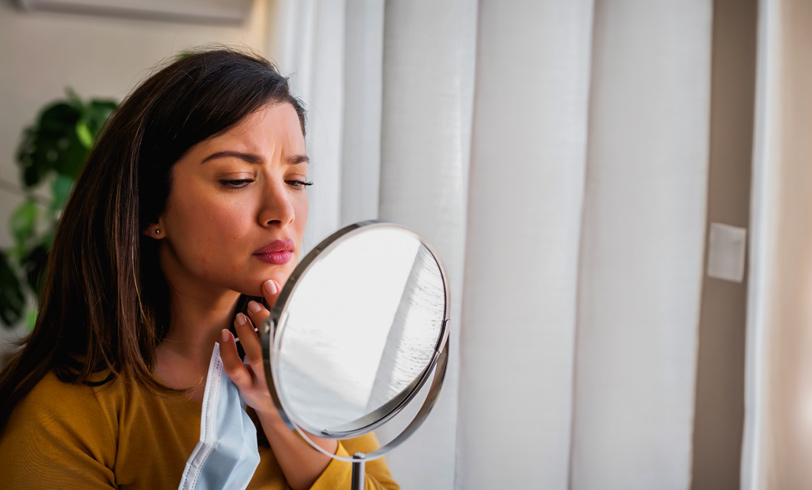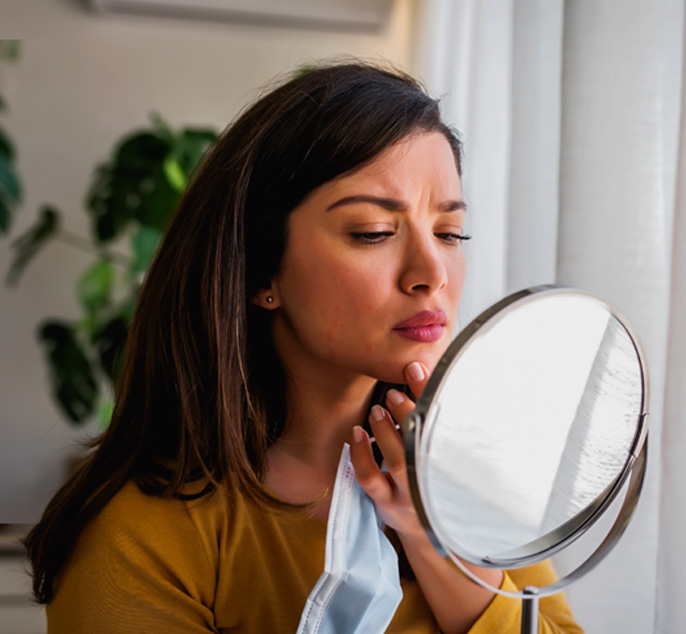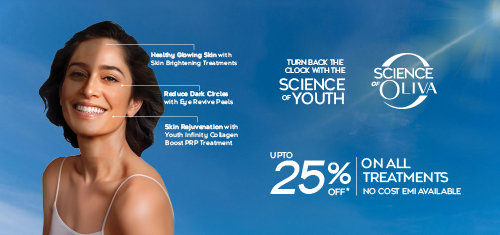

Acne Vulgaris
Types, Images, Causes & Management TipsAcne is a common skin condition that occurs when hair follicles become clogged with oil and dead skin cells, leading to pimples, blackheads, and cysts. While often viewed as a cosmetic concern, severe or persistent acne can significantly impact self-esteem and may lead to scarring. Medical intervention is crucial to address the root cause, prevent complications, and tailor treatments to achieve clearer, healthier skin.
Acne Vulgaris - Meaning And Medical Definition:
Acne vulgaris is a medical term for common “pimples”, “zits” or “breakouts”. The skin disorder affects the pilosebaceous gland, i.e. the hair follicle and the oil gland associated with it. The excessive production of natural oil or sebum combined with the buildup of dead cells and bacteria leads to the clogging of the hair follicles. It results in inflammation and redness in the form of acne.
Facial acne is one of the most widespread skin concern that includes breakouts on the forehead, nose, cheek, chin, jawline and even neck. However, pimples may also appear on other areas of the body, including chest, shoulders, arms and back. Acne usually occurs during the teenage phase due to puberty. However, for some of us, pimples may persist or become more severe during adulthood. Let us find out more about the types, causes and symptoms of acne vulgaris before exploring preventive tips and treatment options.
Causes of Acne Vulgaris
Here are the top reasons for acne you need to know-
-
Stress
A high-stress lifestyle can trigger the activity of sebaceous glands and can result in excess sebum production and acne.
-
Medications
Specific medicines containing androgen, corticosteroids, DHEA, and lithium cause acne as a side-effect.
-
Diet
Regular consumption of sugary foods that have a high glycemic index can also trigger acne.
-
Improper Skincare
Using skincare and makeup products that contain harsh chemicals or are not suitable for your skin type may clog your pores and cause breakouts.
-
Heredity
If either of your parents had acne, then there is a high probability of you having pimples too.
-
Hormonal Changes
Hormonal disorders related to conditions like PCOS can stimulate sebaceous glands to produce more sebum, leading to acne outbreaks. Hormonal changes during puberty, menstruation, pregnancy and menopause too may trigger breakouts.
Types Of Acne
Whiteheads
Whiteheads are closed comedones that appear as small, white and raised bumps on the skin.
Blackheads
Blackheads are open comedones that appear as tiny, dark spots on the skin.
Papules
Papules are small, solid, raised spots on the skin that have a border with edges.
Pustules
Pustules are small, pus-filled lesions on the skin that are larger than whiteheads and blackheads.
Cystic
Cystic acne is the severe form of acne. They are large and pus-filled pimples underneath skin and painful.
Nodules
Nodules or nodular acne is a severe form of acne that appears as large bumps deep under the skin. They are tender and very painful to the touch.
Symptoms
The signs and symptoms of acne vary based on the type and severity of the condition. However, you may note the following if you have acne-prone skin: Clogged pores with white or transparent lesions Redness and inflammation in the form of bumps and rashes Painful pus-filled pimples Cysts with deep abscesses Scar and pigmentation
Clogged pores
Clogged pores with white or transparent lesions
Inflammation
Redness and inflammation in the form of bumps and rashes
Pus-filled
Painful pus-filled pimples
Abscesses
Cysts with deep abscesses
Dark spots
Scars and pigmentation
Diagnosis
An experienced dermatologist can diagnose accurately and recommend treatment options to treat the specific type of pigmentation.
One-on-one Consultation
During an exclusive consultation with our dermatologist, they will look out for the common signs and symptoms during a physical examination.
Evaluate
They will record your family and medical history and lifestyle habits and suggest blood investigations to identify any hormonal imbalance.
Customised Treatment
They will recommend a customised treatment plan based on the underlying cause, type and severity of your acne.
Are you at Risk?
-
In India alone, more than 10 million people complain of acne every year.
-
People who have a family history of acne vulgaris or hormonal issues like PCOS are more prone to breakouts than others.
-
Also, those of you undergoing hormonal changes due to puberty, pregnancy or menopause have an increased risk of having acne.
-
If you have a stressful lifestyle or poor dietary habits, your probability of having pimples is high.
Prevention and Management
Here are the top skincare tips for acne-prone skin recommended by leading dermatologists for the prevention and management of acne:
Cleanse
Wash your face twice a day with a mild cleanser, especially after a sweaty workout.
Use non-comedogenic products
Skincare products containing harsh chemicals. Opt for products labelled non-comedogenic and oil-free.
Do not pop or squeeze
Never pop, squeeze or pick pimples as this may aggravate the inflammation and lead to permanent scarring.
Use a sunscreen
Always use a sunblock cream suitable for your skin type before going out in the sun. Do not forget to use it even on rainy days.
Change pillowcases often
Maintain cleanliness and change your pillowcases every week.
Hydration
Stay hydrated to flush out toxins from your body and minimise acne.
Treatment Options
Treatments Explained
Prognosis
Usually, teenage acne clears up on its own by the mid-20s. Adult acne, especially in women, may persist up to the age of 40.
- Usually, teenage acne clears up on its own by the mid-20s.
- Adult acne, especially in women, may persist up to the age of 40. It generally needs detailed diagnosis and holistic treatment to subside.
- Most adults usually develop mild to moderate acne lesions and seeking immediate treatment may help them prevent recurrence and scarring.
- Acne in its various stages can lead to permanent scars if left untreated during its early onset. Seeking early medical help is advisable.


